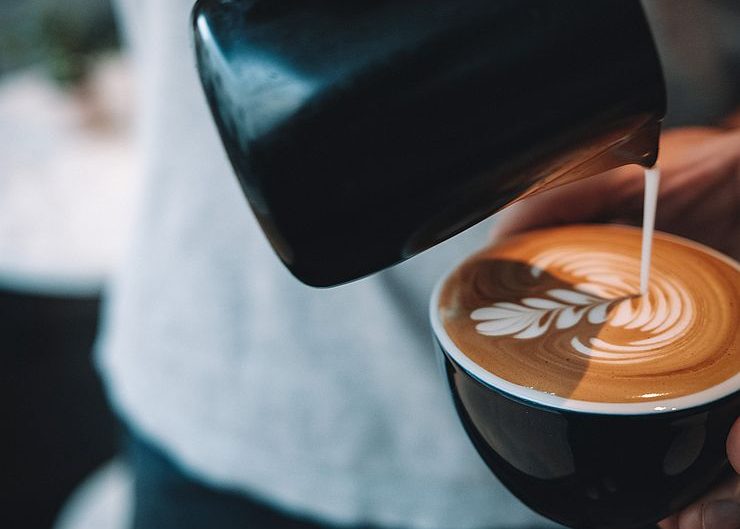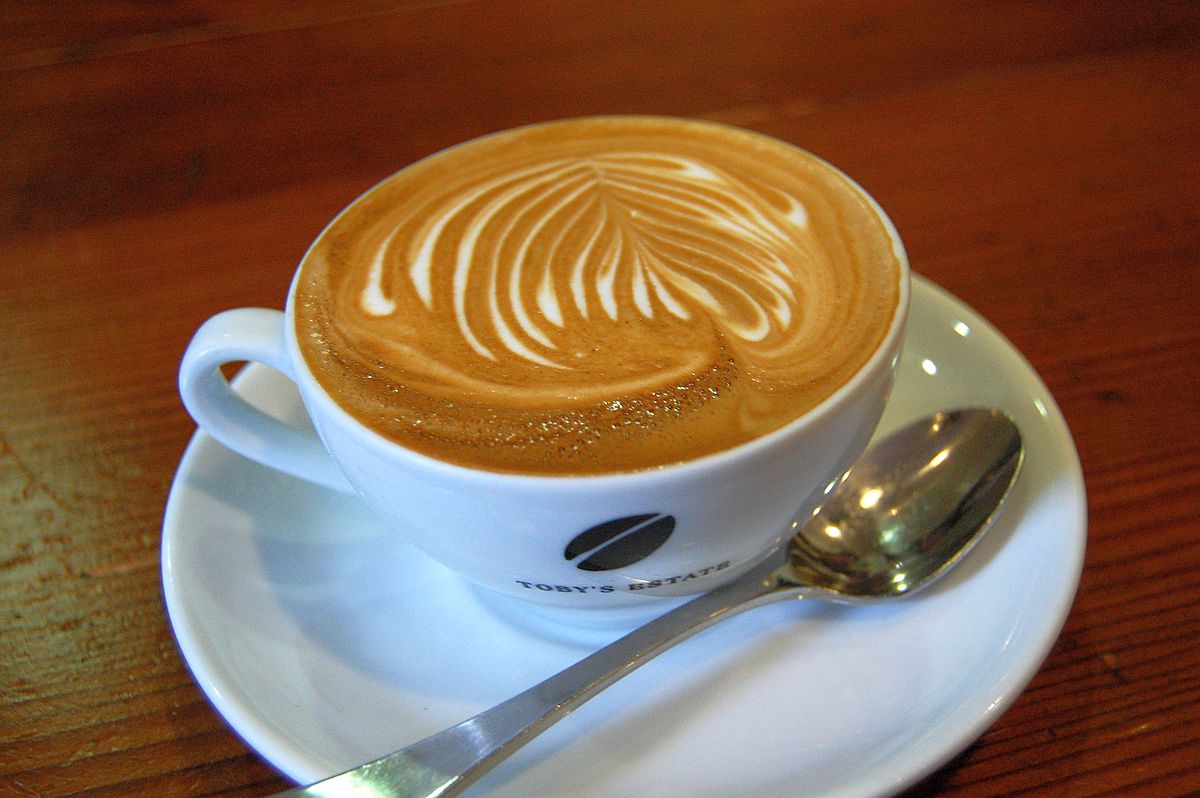The flat white is a milk-based espresso drink similar to latte, and cappuccino. It is typically served in a smaller cup than a latte and is prepared with a double shot of espresso.
Almost always prepared with latte art, the flat white is a very popular drink in the third wave coffee movement.

Origins and History of the Flat White
The earliest reference to a “flat white coffee” appears in the 1962 British film Danger by My Side, according to Wikipedia’s article about flat white. although it is not clear that this refers to the modern drink.
A Sydney newspaper article in April 1984 satirized the caffe latte trend, pointing that “caffe latte translates as flat white“.
The flat white probably originated in Australia in the 1980s. Some people have disputed this fact, asserting that the beverage was created in New Zealand. In the 1990s, this drink gained popularity in these two countries before being exported to other coffee-drinking cultures.
Alan Preston, the owner of the Moors Espresso Bar in Sydney Australia, claims to have invented the flat white. He added the flat white in his coffee shop menu in 1985, after seeing coffee shops in Queensland serving “White Coffee – flat”.
Derek Townsend and Darrell Ahlers of Cafe DKD claim that the beverage was served in their coffee shop as a latte alternative. Craig Miller, author of “Coffee Houses of Wellington 1939 to 1979“, claims to have prepared a flat white in Auckland in the mid-1980s.
What Is the Best Milk to Use for Flat White?
Flat whites can be made with different types of milk, including cow’s milk, soy milk, or almond milk. However, for best results, whole milk is recommended.
Cow’s milk has the optimal balance of sweetness and fat to create a creamy, rich texture in the drink. Soy milk lacks creaminess and can make flat whites taste slightly bitter. Almond milk has a nutty flavor that can overpower other flavors in the drink. Skimmed milk is harder to texturize than whole milk.

What Is The Best Coffee For a Flat White?
A double shot of espresso is the most traditional and popular coffee for a flat white. However, some baristas prefer to use ristretto shots instead.
Ristretto shots are espresso made with less water, resulting in a more intense flavor. They are perfect for making flat whites because they have a stronger coffee flavor that stands up to the sweetness of the milk. When the barista uses ristretto as the coffee base, they usually adjust the number of shots, to compensate for the volume. A triple shot ristretto, is a great alternative, since it will have the same volume, but a lot more flavor and no bitterness.
Espresso alternatives can also be used as the coffee base, though they are only used by home baristas. In a coffee shop, the standard is the espresso. Check our article where we explain What is Espresso, for more on the subject, and view our Guide on Pulling an Espresso Shot to learn the important factors and techniques when making your espresso.
What Ingredients Are in a Flat White?
A typical flat white contains espresso and microfoamed milk. Sometimes contains sugar as well. There are also many ways to flavor the beverage, though the traditional flat white only contains milk and espresso.
Some baristas add flavorings such as hazelnut, caramel, or vanilla syrups to their flat whites. Others like to add a sprinkle of cinnamon or nutmeg for extra flavor. Chocolate is also a popular addition to this drink, and can be stirred in or melted on top of the milk. Note that these are just additions, and they are not part of the original recipe.
How To Make A Flat White?

Making a flat white at home is easy. All you need is an espresso machine and whole milk. Here is a step-by-step guide on how to make a perfect flat white at home:
- Make two espresso shots and pour them into a glass.
- Steam the milk but make sure you don’t create too much froth.
- Pour the textured milk over the espresso.
- Near the end of the milk pour, the thicker microfoam can be used to create a design, if desired.
Here are some more details on how to prepare and serve the perfect flat white.
Flat whites are traditionally served in a ceramic cup with saucer. Milk is steamed to form microfoam, similarly to lattes, but with less stiff foam. The stiffer microfoam, has larger air bubbles, and creates a mound of froth on top of the ceramic cup.
As the barista pours the microfoam, they guide the crema into the froth mound at the top of the beverage, creating a uniform brown color across the top. Alternatively, the barista can create designs using the crema as the canvas, and the thicker microfoamed milk as the paint.
Similar beverages – Flat White Alternatives
In the recent years, many other English-speaking coffee cultures, including Britain, Ireland, and the United States, have adopted the flat white as one of the most popular coffee order.
Similarly, other non-English-speaking European coffee cultures maintain their tradition of serving milk and espresso drinks, such as the café au lait in northern Europe, milchkaffee in Germany, café con leche in Spain, and cappuccino in Italy.
The flat white resembles mostly to a traditional Italian cappuccino – a beverage made with a single espresso with microfoamed milk served in a 150 ml (5 fluid ounce) cup.
Café con leche is also an approximate alternative, but it uses scalded milk instead of steamed milk. Milk steaming retains the fats and proteins giving the drink a sweet flavour. Scalded milk loses this sweetness. A café con leche also lacks the head of microfoam, since the milk is not textured.
The closest drink to a flat white is a cappuccino, from a flavor perspective. A flat white is a bit milkier though, considering that the one third of milk froth, standard in a cappuccino, is replaced with steamed milk in a flat white.
A “dry cappuccino,” which has dry frothy foam but no liquid milk, is the polar opposite of a “flat white.” A dry cappuccino has a lower ratio of milk to espresso.
The flat white and the latte are also quite similar, and many people wrongly assume that they are the closest match. Flat white is a stronger espresso drink, whereas latte is a milkier one.
Flat White vs Cappuccino vs Latte
Flat white is a drink that has cappuccino features, but also has latte features. This why is often confused with the two espresso drinks.
Flat white resembles to cappuccino from a milk quantity perspective. They have a similar ratio of milk to coffee: cappuccino has a 1/3 espresso, 1/3 steamed milk, 1/3 foamed milk, and flat white has a 1/3 espresso, 2/3 micro foamed milk. Steamed milk for a flat white should have the foam layer at the top only one millimeter thick.
The main difference between a flat white and a cappuccino is the type of textured milk used. A cappuccino uses steamed milk and foamed milk, whereas flat white uses microfoamed milk. There is no milk froth in a flat white.
A cappuccino is also more concentrated than a flat white, since the foamed milk third takes up a lot of volume, but doesn’t contribute to the taste of the drink. (It’s more air tan drink.)
The comparison of the flat white to a latte is correct from the textured milk perspective, but the coffee concentration is where the two beverages stand apart.
The main difference between a flat white and a latte is the ratio of espresso to milk. The quantity of milk used per shot of espresso can significantly dilute the coffee flavor. A latte is a milkier, less concentrated coffee with 1/5 espresso and 4/5 steamed milk. Compare that to 1/3 espresso and 2/3 milk of that flat white, and you have an idea. While the texture is similar, the taste is quite different.
A flat white has the same quantity of espresso as the other espresso drinks in the menu. However, it is served in a smaller cup than a latte, so it has less place for milk, hence a stronger coffee flavor than a latte. Lattes are served larger cups, and subsequently milkier. The consistency of the milk is another point of difference between a flat white and a latte – a latte has a creamy, velvety layer of milk on the surface which can vary in depth depending on where you buy your coffee. A flat white has a thinner band of the textured milk, ideally with a shinier surface.
Conclusion
Flat white is a delicious, creamy coffee drink that can be made with different types of milk. It it the perfect choice for those who want a strong coffee flavor without the bitterness of espresso. They are a great alternative to the traditional Italian cappuccino, and a stronger alternative to the milkier latte. Flat white is the perfect choice for those who count calories, but can’t give up the milk in their coffee.
